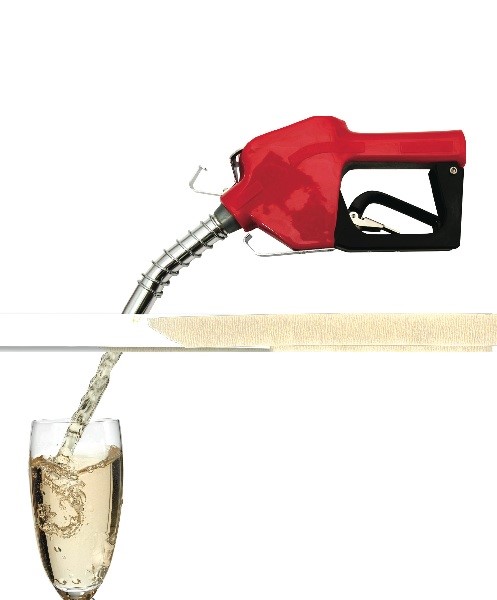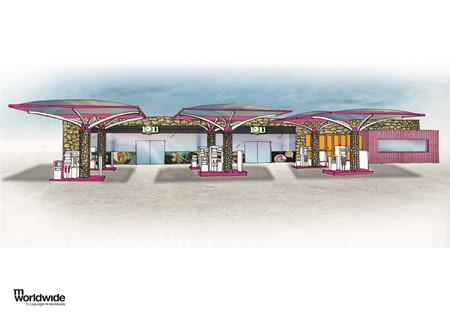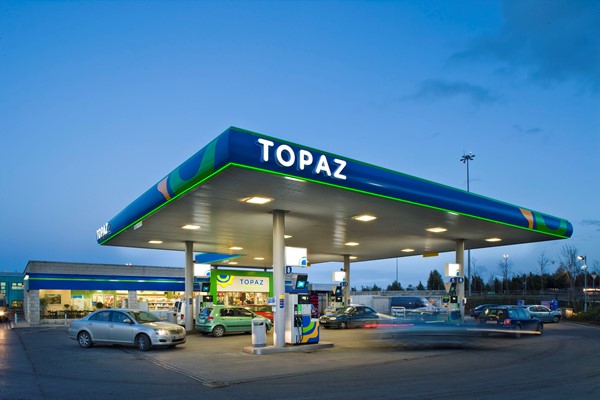Buried treasure: Changing the forecourt retail experience

Forecourt retail is a long-neglected sector, yet it has the potential to have an impact on the bottom line of fuel retailers. How can companies reinvigorate this sector with a focus on brand experience and design. Brittany Golob investigates
Bricks and mortar retailers value their physical spaces for their ability to draw footfall, build brand awareness and increase loyalty. Forecourt retail has long suffered from a lack of interest on the part of the corporate brand. Yet, petrol companies are slowly realising that their retail sites are a hidden treasure. They have the potential to drastically increase the commercial value of the forecourt.
Drivers prioritise speed, convenience and trust when choosing where to service their vehicles. Petrol has become a sector ruled by price comparison. Building a connection between the brand and consumer is enough to drive any brand round the bend. Thus, brand experience has become a key focus as brands seek to maximise returns on their commercial sites.
Yet, changes have rocked the sector over the past few years, leading to a stronger focus on commercial success. Petrol retailers have had to face competition from other sectors like supermarkets and from other convenience-oriented food service brands – the Starbucks and Tescos of the world. Complicating the challenge facing global and regional petrol brands alike are the differences in local preferences regarding food service, use of service stations and the definition of convenience
"In certain countries, users want to go in and have an espresso out of a real ceramic cup, so they do use it as a place to relax,” says New York-based brand agency CBX’s vice president and engagement director, Dave Weinberger. He says brands in Europe and South America have taken the approach of designing their retail outlets to feel like cafes. But, that’s not a tack that works in all markets, he warns. “In the U.S., the last thing Wawa wants you to do is sit in one of their stores and hang out. But people love Wawa. People do congregate there, but it’s not a place that people hang out.” Understanding those local distinctions is crucial for a successful brand experience.
The challenges are myriad in forecourt retail. Petrol companies rarely have a brand story that is relevant to their retail offer. Most focus on getting fuel out of the ground and into consumers’ tanks. That doesn’t make for a compelling emotional connection to the brand. “Fuel in itself is a low- interest category,” says joint managing director for retail design and strategy agency M Worldwide David Martin. “Pure branding or brand application is what oil companies have done historically. They’ve done a lot of badging and a lot of territorial owning, but in terms of emotive connections or reasons why people should stop there, once you get past hygiene factors, what are the other reasons that would get somebody to stop?” Martin says branded fuel additives and price differentials don’t sway consumers anymore who are looking for a quality experience in addition to the convenience of getting back on the road quickly. That alone doesn’t amount to a compelling brand story.
Peter Koomen, managing director of global brand implementation company GLIMMA, agrees, “On a long trip, faced with a choice of familiar service stations, research shows that many consumers will elect the station that serves them best, even if it is further away, and not necessarily the first one they come to.” GLIMMA helped BP revamp their toilet facilities across Europe which yielded better footfall but also allowed BP to better communicate its environmental sustainability messages.
Hygiene factors and convenience are not the only challenge. Petrol stations are in competition with other sectors – supermarkets, club stores like Costco, convenience chains, roadside cafes – many of which have existing loyal customer bases or trusted brands in regards to quality of food and drink. Convenience chains like Little Waitrose in Britain and 7-Eleven in North America have earned trust due to their food and drink offer and compete heavily with branded forecourt retail. Often, however, petrol purveyors pair up with these stores to bring local trusted brands to the forecourt, to much success.
Food and drink insights company IGD says convenience yields profits of about £37.7bn per year, but growth is flat in forecourt retail, year-on-year.
“In such a competitive landscape, the brand experience is vital in gaining an advantage. A key aspect of this is tailoring the offer to the local neighborhood”

In order to rediscover the value of forecourt retail, brands should ensure a consistent, yet localised, quality experience. “In such a competitive landscape, the brand experience is vital in gaining an advantage. A key aspect of this is tailoring the offer to the local neighborhood, appealing directly to the needs of specific audiences. A one-size-fits-all approach to convenience and forecourt formats is increasingly failing to meet the expectations of shoppers spoilt for choice,” Jim Whyte, head of insights at Fitch, which specialises in brand experience, says.
Forecourt retailers have their work cut out for them. Some have already alit upon ingenious solutions to the problems plaguing brand loyalty and design.
Couche-Tard is a major Quebec-based convenience chain that has grown by acquisition. As brand guardian for scores of local and larger brands, its offering had become muddled, particularly with regards to internal culture. Brand experts point to culture as a key aspect that can allow for differentiation in the sector.
Couche-Tard had to create a point of consistency among its family of brands. It announced in September that all of its outlets worldwide, barring those in Quebec, would be rebranded as Circle-K – one of the company’s most well-known sub- brands. Brian Hannasch, president and CEO of Couche-Tard said at a press conference, “As we continue to grow we’ve been faced with a significant question. Do we continue the recipe we’ve had which is a company of companies or do we join together to be one company, one business? Who are we in these new geographies? Do we stay with the local brands or consolidate under one brand and if so what brand would that be?”
These questions led to a global rebrand that will impact the consumer brand but will also cause an examination of products and services with the aim of improving customer experience. He emphasised that the focus on employees and service was a key motivation for the rebrand. Yet, the Couche-Tard retail brand will remain as is in Quebec, it’s home. The owl logo and heritage brand are well-loved in the province, Hannasch says, and will retain their distinct brand despite the global Circle-K rebrand.
Roger Hart, CEO at brand storytelling agency Aesop says employee culture directly relates to customer experience. By better communicating with the internal audience, retailers can see a marked difference in terms of brand experience. Aesop recently worked with Shell to implement a global induction programme that introduced all frontline employees – hired directly or by franchisees – to Shell in a uniform way, but also catered to local differences in terms of staff culture and customer expectations.
Other brands ensure local differences are catered to when rebranding or updating a forecourt. New Chinese brand VIV had to compete with global and strong local companies and thus took a consumer-centric approach that aimed to put the forecourt at the centre of the community.
CBX, which has worked with a number of regional fuel brands, ensured a measure of local character was imbued into each site. That often meant a redeveloping of the canopy itself – an area that most say should be addressed when improving brand experience on the forecourt. Topaz, an Irish brand, was rebranded in natural blues and greens to blend in with Ireland’s natural beauty. Action, in Argentina, has dedicated cafe seating areas that cater to the local consumers’ desires for a quality cup of espresso served in a mug, as well as the opportunity to rest in a cafe setting.

Janey Fry, design director at brand consultancy Conran Design Group, says, “Different markets have a variety of forecourt service, product and facility expectations; in some markets, consumers don’t necessarily have to get out of their vehicles to purchase fuel. The key is to understand the local culture, benchmark and leapfrog competition and respond to the nuances of local consumers.”
Localising the convenience offer prioritises interior design and the shopping experience. Koomen says brand is one of the few things that can differentiate a petrol company. They should focus on creating a “highly branded” retail environment. Martin says, “Experience has not really been on the agenda historically. Not all fuel stations are very bad, but it was functional at best.” He says a focus on brand experience and design can drastically improve the sector, in the way that rail operators have focused on their stations and retail spaces to maximise efficiency.
He adds, “There’s so much physical space but also visual space and branding given over to this functional. Low-interest category, whereas this part that’s actually interesting is tucked away in the back. If you were to build new sites, you probably wouldn’t arrange them as they are at the moment.”
Whyte agrees, “Visual branding is of course a powerful means of communicating with the customer, however, in the scramble for advantage in the convenience sector it’s been increasingly difficult to use this as the sole means of gaining advantage. Greater attention should be given to providing a seamless brand experience for the customer, irrespective of the format they choose to use.”
The brand work the likes of Couche-Tard and Shell have been focusing on is one way to future-proof forecourt retail against competition from other sectors. More could be done, though, some say, to reimagine the experience of the forecourt entirely. Martin says the retail space should be the primary draw, with the actual forecourt taking a backseat, thus enhancing footfall.
Hart points to innovative multi-service retail centres where packages can be delivered, grocery shopping can be done and stop-and-go purchases made, all in the same space. “The site can add additional services that make it a much more commercially viable entity,” he says. “That will hopefully make a difference to where you will drive that extra mile. When you’re on that site you connect with the brand, that dries awareness of the corporate brand.”
CBX has already experimented with the canopy design with Action’s sites, drawing people in with an unconventional design that focuses on technology. Martin likens the canopy to a retail front door. If it were designed to be less industrial and more welcoming, it would account for a better brand experience.
Technology, too, can have a role to play in the rebirth of forecourt retail. Some are already recognising this and introducing quality vending offerings and pay-at-the-pump services, but most experts say there’s a way to go to integrate technology better into the forecourt experience.
Forecourt retail is a buried treasure for corporate petrol brands, but there is much to be done to create a service-based, positive brand experience that is tailored to local preferences. Yet, changes are in motion as fuel companies recognise the hidden potential of their retail spaces.


